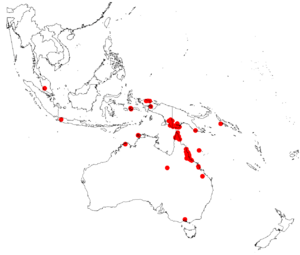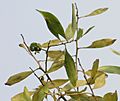Hickory wattle facts for kids
Quick facts for kids Hickory wattle |
|
|---|---|
 |
|
| Conservation status | |
| Scientific classification | |
| Genus: |
Acacia
|
| Species: |
mangium
|
 |
|
| Occurrence data from AVH | |
| Synonyms | |
|
|
Acacia mangium, also known as hickory wattle or black wattle, is a type of flowering tree. It belongs to the pea family, called Fabaceae. This tree naturally grows in northeastern Queensland in Australia, parts of Papua New Guinea, and the eastern Maluku Islands. People use Acacia mangium for managing the environment and for its wood.
A scientist named Carl Ludwig Willdenow first described this tree in 1806. He found it growing in the Moluccas, which are islands in Indonesia.
Contents
How Acacia mangium Grows
Acacia mangium trees can grow very tall, up to 30 meters (about 98 feet) high. They often have a straight trunk. Each kilogram of A. mangium seeds contains about 142,000 seeds.
To help the seeds sprout, they need special treatment. You can scratch the surface of the seed or put it in boiling water. This helps the seeds grow quickly, usually more than 75% of them will sprout.
Like many other legumes (plants in the pea family), Acacia mangium can add nitrogen to the soil. This process is called nitrogen fixation. It helps make the soil healthier for other plants.
A. mangium is a popular tree for planting in forests and for agroforestry projects. In mixed forests, other plants can benefit from the shade of A. mangium and the nitrogen it adds to the soil.
This tree can grow in soils that are not very fertile or that don't drain well. However, it grows best in rich soils that drain water easily. How deep the soil is and where the tree is located on the land can also affect how well it grows.
Trees closer to the equator usually grow faster, adding about 3 to 4 meters (10 to 13 feet) in height each year. Trees planted further from the equator grow more slowly.
What Acacia mangium is Used For
Timber
Acacia mangium trees produce two types of wood: sapwood and heartwood. The heartwood is brownish-yellow and has a medium texture. This wood is very heavy, hard, and strong. It doesn't usually warp or crack easily.
Because of these qualities, Acacia mangium wood is used to make furniture, doors, and window frames. After being polished, the wood becomes shiny and smooth. This makes it good for creating beautiful parquet flooring tiles and other decorative items for export.
Pulp and Paper
A. mangium is known as an excellent source of short cellulose fibers. These fibers are important for making paper. Because of this, the tree is grown in large plantations in Southeast Asia, especially in Indonesia.
Helping Soil and Restoring Land
Acacia mangium trees help improve the soil. They increase how quickly nitrogen moves through the topsoil, which means more nitrogen is available for other plants. This is especially helpful when A. mangium is grown with other plants.
Since it's a very fast-growing tree, it develops a strong root system. This is very useful in soils that are not very fertile. Its roots help to fix and improve damaged tropical lands.
For example, in Goa, India, this tree is widely used in the mining industry. It helps to restore waste areas left by mining because it can handle dry conditions and helps hold together the rocky mine waste. In Colombia, it has been used to restore land damaged by open-pit gold mining.
Gallery
-
Trunk in Kolkata, West Bengal, India.
-
Tree in Kolkata, West Bengal, India.
-
Leaves with fruit pod at canopy in Kolkata, West Bengal, India.
-
Leaves at canopy on the branchesin Kolkata, West Bengal, India.
-
Leaves at canopy in Kolkata, West Bengal, India.
See also
 In Spanish: Acacia mangium para niños
In Spanish: Acacia mangium para niños











